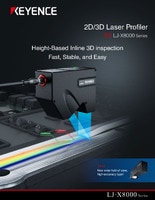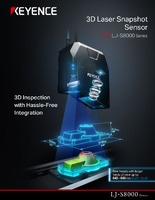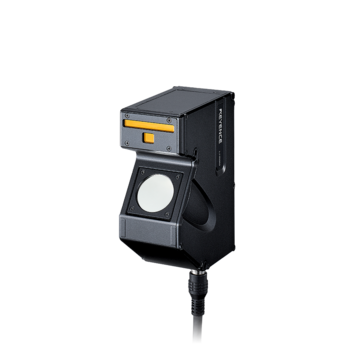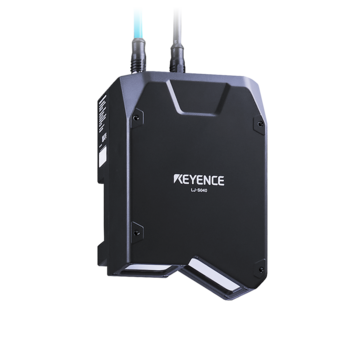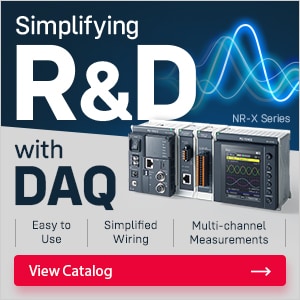Measurement Sensors
Dimension Measurement
Displacement Measurement
Sensors for High-Precision Welding Automation

KEYENCE’s advanced sensors can provide precise measurements, monitoring, and control throughout the automated welding process. From seam tracking to real-time defect detection, these technologies ensure consistent, high-quality results.
The Role of Sensors in Welding Automation
Sensors act as the eyes and ears in the automated welding process, monitoring variables to ensure that every weld meets its exact specifications. Sensors also allow welding automation systems to dynamically adapt if an issue were to arise. They can also help correct concerns such as distortion or inconsistent weld seams on the fly.
With automated laser welding, sensors align a laser beam with the target material, giving high-quality welds in complex scenarios. Similarly, in automated spot welding, sensors ensure accurate and consistent current flow. These capabilities minimize errors and maintain quality.
These sensors help maintain precise movements between the welding arm and the workpiece for consistent weld quality. They also detect anomalies or overheating that could put operators in danger.
We’re here to provide you with more details.
Reach out today!

Types of Automated Welding Supported by Sensors
Sensors enhance the capabilities of different automated welding methods. They enable automated welding machines to adapt to a multitude of tasks, from inline production to specialized and intricate tasks. Below are different types of welding automation that have been improved by the introduction of sensors.
Gas Metal Arc Welding (GMAW)
GMAW, often referred to as MIG welding, is widely used for its speed and adaptability. Sensors in these systems regulate wire feed rates, gas flow, and arc length, ensuring consistent weld penetration and minimal spatter. This welding automation supports high-volume operations across industries.
Hybrid Welding Systems
Hybrid welding, which combines techniques like arc welding with lasers or other advanced methods, demands a high degree of control. Sensors in hybrid systems control heat input and keep systems synchronized. This makes hybrid welding ideal for tasks requiring speed and flexibility without compromising on safety.
Plasma Arc Welding
Plasma welding uses sensors to stabilize the arc and maintain a consistent flow of plasma gas. This level of control is necessary when handling thin-gauge materials, especially in aerospace components and medical devices.
The process of incorporating welding automation into existing practices helps manufacturers maintain quality while producing more products. A manual inspection of welds costs time and money, and an advanced 3D sensor provides real-time inspection data without the downtime.
We’re here to provide you with more details.
Reach out today!

Laser Welding Automation
Laser welding automation combines precision sensors to enable real-time monitoring to detect changes in beam alignment or heat distribution, preventing defects and enhancing reliability. They can even create intricate components that have tight tolerances and zero room for error. Automated laser welding can handle the most complex geometries or variable material thicknesses.
Spot Welding Automation
Laser welding might offer top-of-the-line precision for intricate tasks, but for high-speed, high-volume productions, spot welding automation is the go-to. By using sensors to monitor currents and heat levels, this technique can keep every weld consistent and ensure that the welds are up to quality standards. The sensors also help minimize defects and material waste, which means spot welding is a cost-effective solution for repetitive manufacturing tasks.
Benefits of Using Sensors in Automated Welding Systems
Sensors that have been integrated into welding automation systems work to transform the production process and provide unmatched reliability. They improve weld precision and also enable systems to adapt to dynamic conditions.
Ready to take your organization’s welding automation processes to the next level? At KEYENCE, we are at the forefront of sensor technology, and our experts can help you no matter the challenge!
Contact us today to learn how KEYENCE sensors can transform your operations.
Contact us to learn more about how our advanced technology can help take your business to the next level.
Contact Us
Related Products
Applications
Dimension Measurement
- Thickness and Width Measurement
- Step Height Measurement
- Inner and Outer Diameter Measurement
- Measuring Angles
- Meandering/Edge Measurement
Displacement Measurement
- Positioning and Stroke Length Measurement
- Vibration and Runout Measurement
- Deflection Measurement
- Measuring Eccentricity

